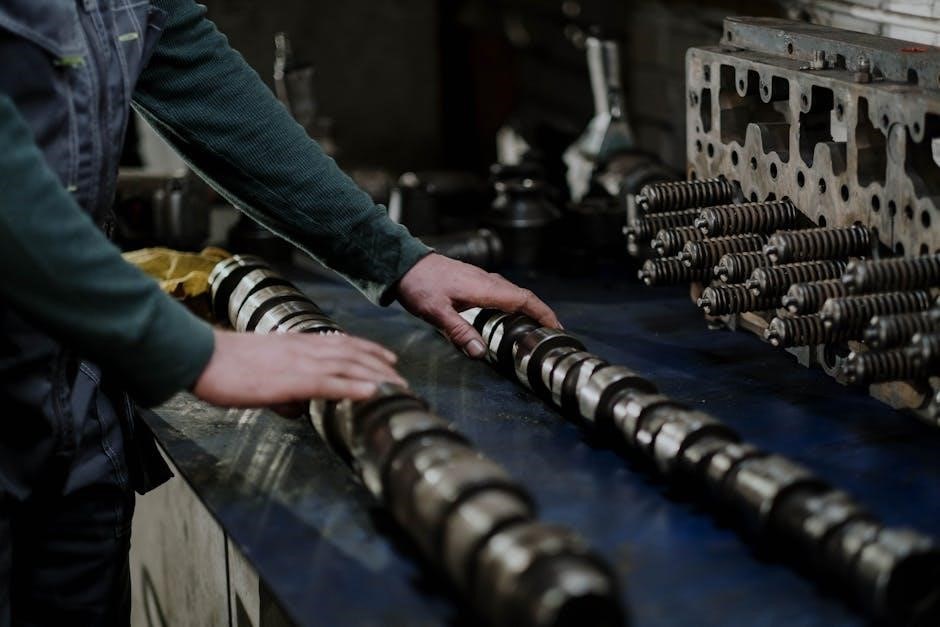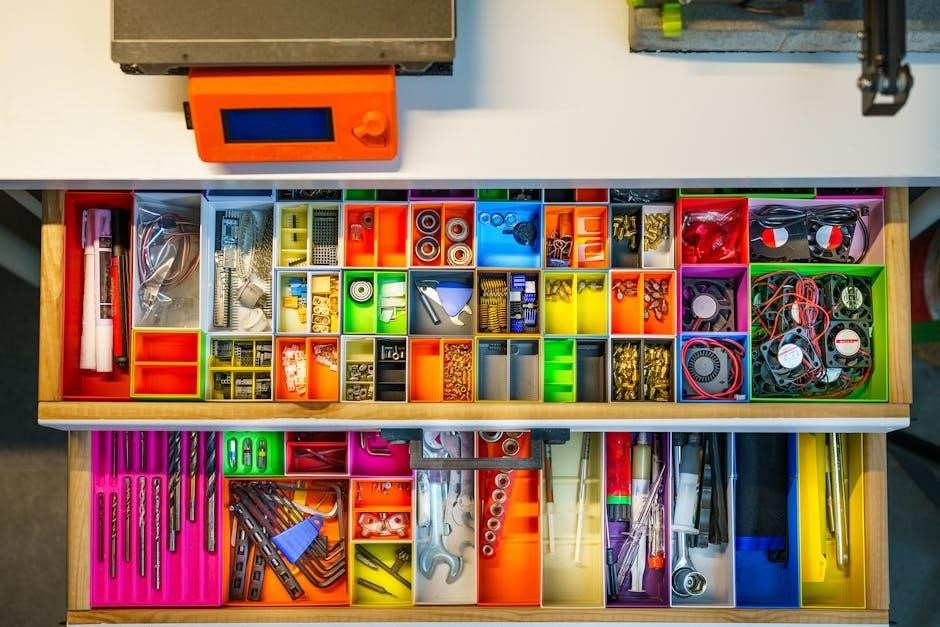The Kaivac 1250 Parts Manual provides essential information for operating, maintaining, and repairing the Kaivac 1250 cleaning system. It ensures safe and effective use of the machine, covering key components, troubleshooting, and replacement procedures. This guide is designed to help users maximize the lifespan and efficiency of their Kaivac 1250.
Overview of the Kaivac 1250 Cleaning System
The Kaivac 1250 is a corded, manually operated mobile cleaning station designed for No-Touch cleaning. Its lightweight frame ensures easy maneuverability, allowing users to reach various areas effortlessly. The system features a 12-gallon water tank and combines an indoor power washer with a powerful wet vacuum for efficient cleaning. It is engineered for reliability and durability, making it suitable for a wide range of cleaning tasks. The Kaivac 1250 is a versatile solution for maintaining cleanliness in different environments, offering both power and portability in a compact design.
Importance of Using the Parts Manual
The Kaivac 1250 parts manual is essential for the safe and efficient operation of the machine. It provides comprehensive instructions for setup, operation, and routine maintenance, helping users avoid potential hazards. The manual includes troubleshooting guides to diagnose and resolve common issues promptly, minimizing downtime. Clear part diagrams and schematics are included, simplifying the identification and replacement of components. Adhering to the manual’s guidelines ensures optimal performance and extends the machine’s lifespan. The availability of the manual in a downloadable PDF format offers users easy access, allowing them to quickly reference essential information whenever needed. This ensures that users can maintain their Kaivac 1250 effectively and efficiently.

Safety Precautions and Guidelines
The Kaivac 1250 requires strict adherence to safety guidelines to prevent accidents. Always disconnect from power during maintenance or repairs, and avoid heated surfaces or unstable supports. Ensure the operating area is clear of obstacles and personnel. Follow proper shutdown procedures and never operate without essential safety components installed. Regularly inspect cords and components for damage. Adherence to these precautions ensures safe and effective operation of the machine.
General Safety Tips for Operating the Kaivac 1250
Operating the Kaivac 1250 requires attention to safety to prevent accidents and ensure effective performance. Always maintain a clear operating area, free from obstacles and personnel. Disconnect the machine from power during maintenance or repairs, and avoid using it near heated surfaces. Never stand or reach on unstable supports, and keep the cord away from heat sources. Ensure the float is installed during operation, as removing it can compromise safety. Regularly inspect the machine for damage, and follow proper shutdown procedures. By adhering to these guidelines, users can safely and efficiently utilize the Kaivac 1250 for their cleaning tasks.
Precautions During Maintenance and Repair
When performing maintenance or repairs on the Kaivac 1250, always disconnect the machine from the power source to prevent accidental start-ups. Ensure the area is clear of personnel and obstacles to avoid potential hazards. Never stand or reach on unstable supports, and keep the cord away from heated surfaces. Use only identical replacement parts to maintain safety and performance. Properly inspect all components, such as hoses and tanks, before resuming operation. Follow the manual’s guidelines for disassembling and reassembling parts to prevent damage. By adhering to these precautions, users can ensure a safe and effective maintenance process, minimizing risks and prolonging the machine’s lifespan.

Parts and Components of the Kaivac 1250
The Kaivac 1250 includes a 12-gallon water tank, powerful wet vacuum, and indoor power washer. The manual provides exploded diagrams, part numbers, and component descriptions for easy identification and replacement.
Major Components and Their Functions
The Kaivac 1250 features a 12-gallon water tank, a powerful wet vacuum motor, and an indoor power washer. The vacuum hose connects to the recovery tank, while the spray wand delivers cleaning solution. The manual highlights exploded diagrams of major components, such as the horn assembly and float mechanism, ensuring easy identification. Each part is listed with its function, aiding in troubleshooting and maintenance. Understanding these components is crucial for optimal performance and longevity of the machine.
Identifying Parts Using the Manual
The Kaivac 1250 Parts Manual includes detailed exploded diagrams and part numbers to help users identify components accurately. These diagrams visually represent each part’s location and function, making it easier to recognize and order replacements. The manual organizes parts by section, such as the vacuum motor, water tank, and spray wand, ensuring quick access to specific information. By referencing the part numbers and descriptions, users can avoid errors when ordering or replacing components. This systematic approach ensures that users can efficiently locate and identify parts, reducing downtime and streamlining maintenance processes.

Operating the Kaivac 1250
Plug in the machine, check all switches, and ensure the vacuum motor is operational. Turn on the vac motor and proceed with extraction, rotating the horn assembly as needed for effective cleaning.
Setting Up the Machine for Use
Before operating the Kaivac 1250, ensure the machine is properly set up. Start by carefully unpacking and inspecting the unit for any shipping damage. Check all components, including the vacuum hose, horn assembly, and water tank, to ensure they are intact and securely connected. Plug in the machine and verify that all switches are in the correct position. Turn on the vacuum motor to test its functionality. Rotate the horn assembly to the desired position for optimal cleaning. Always ensure the float is installed and functioning correctly before use. Keep the operating area clear of obstacles and ensure the cord is away from heated surfaces for safe operation.
Step-by-Step Operation Guide

Begin by filling the 12-gallon water tank and ensuring the vacuum hose is securely connected to the recovery tank. Plug in the machine and turn on the vacuum motor to test its suction power. Once the machine is powered on, adjust the water pressure as needed using the control dial. To start cleaning, squeeze the trigger on the horn assembly to release water and simultaneously activate the vacuum for extraction. Move the nozzle slowly and evenly across the surface to ensure thorough cleaning. For optimal results, maintain a consistent distance between the nozzle and the surface. After completing the cleaning task, shut off the water flow and vacuum motor. Always ensure the cord is kept away from water and heated surfaces during operation.
Shutting Down the Machine Properly

Proper shutdown of the Kaivac 1250 is essential to ensure longevity and safety. Begin by turning off the vacuum motor and unplugging the machine from the power source. Drain the water tank completely to prevent any residual water from causing damage or mold growth. Wipe down all surfaces and clean the nozzle and hose to remove any debris. Store the machine in a dry, cool place, ensuring the cord is neatly wrapped and not damaged. Regularly inspect the machine after shutdown to identify any potential issues before the next use. Following these steps ensures the Kaivac 1250 remains in optimal condition for future operations.

Maintenance and Troubleshooting
Regular maintenance ensures optimal performance and longevity of the Kaivac 1250. Check filters, hoses, and connections for wear or blockages. Troubleshoot common issues like clogs or motor malfunction promptly to avoid downtime.
Routine Maintenance Tasks
Regular maintenance is crucial for the Kaivac 1250’s efficiency. Check and replace filters every 3 months or as needed. Inspect hoses for cracks or damage and replace them if necessary. Ensure all connections are secure to prevent leaks. Clean the vacuum tank and spray nozzle regularly to avoid clogs. Lubricate moving parts to maintain smooth operation. Additionally, inspect the power cord for wear and ensure proper storage to prevent damage. Always refer to the parts manual for specific guidelines and recommended replacement intervals. Regular maintenance helps prevent unexpected breakdowns and extends the lifespan of your Kaivac 1250.
Troubleshooting Common Issues
Common issues with the Kaivac 1250 include clogged spray nozzles, weak vacuum performance, or power malfunctions. For clogs, check and clean the nozzle regularly. If the vacuum is weak, ensure the tank is not full and the hose is properly connected. For power issues, verify the cord is intact and the outlet is functioning. Refer to the parts manual for detailed troubleshooting steps. If problems persist, inspect for worn or damaged parts and replace them as needed. Regular maintenance can help prevent these issues, ensuring optimal performance of your Kaivac 1250 cleaning system.
Winterization and Storage Tips
Proper winterization and storage of the Kaivac 1250 are crucial to maintain its performance and longevity. Start by draining the water tank completely to prevent freezing and damage. Add a rust-inhibiting solution if storing in freezing temperatures. Clean the machine thoroughly, paying attention to the vacuum hose and spray nozzle. Store the Kaivac 1250 in a dry, protected area away from direct sunlight. Disconnect the battery if equipped, and cover the machine to shield it from dust. Before storing, inspect for any damage or wear and address it promptly. Always refer to the parts manual for specific winterization instructions tailored to your model. Proper storage ensures the machine remains ready for use when needed.

Repair and Replacement of Parts
The Kaivac 1250 parts manual provides detailed guidance for diagnosing and replacing components. Use exploded diagrams to identify parts, ensure correct replacements, and follow safety precautions during repairs.
Diagnosing Faulty Parts
Diagnosing faulty parts in the Kaivac 1250 requires a systematic approach. Start by consulting the parts manual to identify symptoms and potential causes. Perform a visual inspection of components like the vacuum motor, water pump, and hoses for signs of wear or damage. Check for error messages or unusual noises during operation. Use the manual’s troubleshooting guide to isolate issues. Test individual components, such as the float or spray nozzle, to determine functionality. Refer to exploded diagrams for clear identification of parts. Always ensure the machine is disconnected from power before diagnosing. This methodical process helps pinpoint faulty parts efficiently, ensuring timely repairs and minimizing downtime.

Replacing Common Wear and Tear Parts
Regular replacement of wear and tear parts is crucial for maintaining the Kaivac 1250’s performance. Common parts that may need replacement include the vacuum hose, gaskets, seals, and spray nozzles. Always disconnect the machine from power before starting any replacement. Use genuine Kaivac parts to ensure compatibility and performance. Refer to the parts manual for exploded diagrams and step-by-step instructions. Replace worn-out hoses to prevent leaks and maintain suction power. Inspect and replace gaskets and seals to avoid water leakage. Clean or replace clogged spray nozzles to ensure proper water flow. By addressing these replacements promptly, you can extend the lifespan of your Kaivac 1250 and keep it operating efficiently.
Returning Parts for Warranty or Repair
When returning parts for warranty or repair, ensure all components are included in their original packaging with manuals and accessories. Items must be in resalable condition to be eligible for returns or exchanges. Contact Kaivac customer service to obtain a return merchandise authorization (RMA) number, which is required for processing. Ship the parts securely, using appropriate packaging to prevent damage. Include a copy of the original invoice or proof of purchase. Repairs under warranty must be authorized by Kaivac to avoid additional charges. Follow the provided return shipping instructions carefully to ensure timely processing. Properly documented and packaged returns will be addressed promptly, ensuring minimal downtime for your Kaivac 1250 operations.

Accessories and Additional Resources
The Kaivac 1250 supports various accessories, such as hoses, brushes, and cleaning solutions, to enhance functionality. Additional resources, including downloadable manuals and support guides, are available online for troubleshooting and parts replacement, ensuring optimal performance and maintenance of the machine.
Compatible Accessories for the Kaivac 1250
The Kaivac 1250 is compatible with a variety of accessories designed to enhance its cleaning capabilities. These include extended hoses, interchangeable brushes, and specialized cleaning solutions tailored for specific surfaces. Additional accessories like replacement nozzles, vacuum filters, and maintenance kits ensure optimal performance. Users can also explore optional attachments for unique cleaning challenges, such as tight spaces or heavy-duty messes. These accessories are available through Kaivac’s official website or authorized distributors. Using genuine Kaivac parts ensures compatibility and maintains the machine’s efficiency. Exploded diagrams in the manual help identify the correct accessories for your needs, making it easier to order and install them for uninterrupted operation.
Downloading the Latest Manual Updates
Downloading the latest updates for the Kaivac 1250 parts manual ensures access to the most current information, including new features, safety guidelines, and troubleshooting tips. Users can easily find the manual on Kaivac’s official website or through authorized distributors. The manual is available as a downloadable PDF, allowing for convenient access and printing. Regular updates may include revised part diagrams, maintenance instructions, or new accessory compatibility. Always download from trusted sources to ensure authenticity. Kaivac provides clear instructions on their website for locating and downloading the latest versions. Staying updated guarantees optimal performance and compliance with safety standards. Visit the Kaivac support page for direct links to the most recent manual updates.
The Kaivac 1250 parts manual is a vital resource for maintaining and troubleshooting your cleaning system, ensuring optimal performance and longevity through proper use and care.
Final Tips for Using the Parts Manual Effectively
To maximize the effectiveness of the Kaivac 1250 parts manual, always familiarize yourself with its contents before performing maintenance or repairs. Reference the manual regularly to ensure proper procedures are followed. Keep the manual in an accessible location to avoid delays during troubleshooting. Use the exploded diagrams and part numbers to identify and order replacement parts accurately. Regularly check for updates to the manual, as new information or corrections may be added. By following these tips, you can ensure safe, efficient, and correct maintenance of your Kaivac 1250, extending its lifespan and maintaining peak performance.
Maximizing the Lifespan of Your Kaivac 1250
To extend the lifespan of your Kaivac 1250, adhere to the maintenance and operation guidelines outlined in the parts manual. Regularly inspect and clean the machine, paying attention to the vacuum hose, tank, and other high-wear components. Schedule routine maintenance tasks, such as filter replacements and lubrication of moving parts, to prevent premature wear. Properly winterize the machine by draining fluids and storing it in a dry, protected area to avoid damage from freezing temperatures. Following these practices ensures optimal performance and longevity, reducing the need for costly repairs and extending the service life of your Kaivac 1250.

Write Reviews
Leave a Comment
No Comments & Reviews